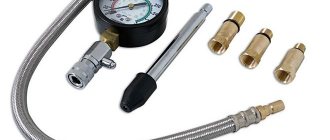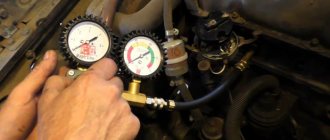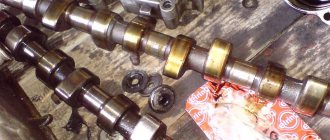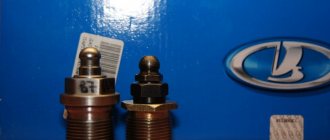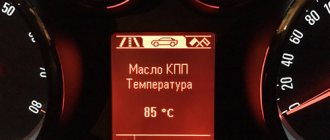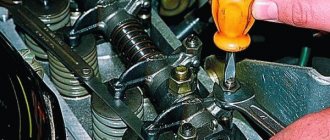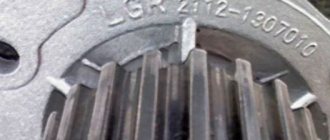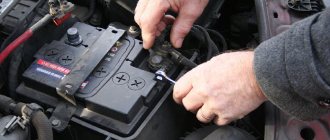How can you measure the value of an indicator?
Compression is measured with special pressure gauges (compressometers).
When choosing the device you need, pay attention to the following characteristics:
- for which engine, diesel or gasoline, it is intended - this can also be determined by the measurement range indicated on the scale of the device;
- a method of connecting the tip of the device to a hole in the cylinder - the so-called clamping tips do not require screwing into the hole and therefore allow you to take measurements much faster than threaded ones, but require the participation of an assistant who will turn on the starter, cranking the engine when you tightly press the tip of the compression gauge to the spark plug hole in the engine head;
- the presence of suitable threads on the tip (or on the adapter) if you do the work alone;
- the presence of a flexible hose of sufficient length in cases where direct access to the spark plug holes is difficult.
The compression gauge is selected based on the type of engine and the method of connecting the tip of the device to the hole in the cylinder
How to measure correctly
How to take measurements correctly? To do this, you need to warm up the engine to operating temperature (80–90 degrees Celsius).
If the engine does not start, then you can measure the compression when it is cold.
It should be taken into account that the measured values will be lower, and the practical value for assessing the condition of the engine will no longer be the compression value, but its differences for different cylinders.
Then the spark plugs are removed from all engine cylinders at once.
This is necessary so that cylinders not used in a particular dimension do not create additional resistance when cranking the crankshaft.
High-voltage wires must be marked so as not to confuse them when installing the spark plugs back. For safety reasons, disconnect the primary circuit wires from the ignition coils.
Disconnect the power system by removing the fuel pump fuse if it is electric or by disconnecting the fuel hose to avoid fuel being injected into the cylinders during the test.
The battery must be in good condition and well charged to allow the starter to rotate the crankshaft at the required speed, since the accuracy of the measurements also depends on this.
To take into account all the features of your car when performing work, it is a good idea to get a repair manual and study it carefully.
When everything is ready to do the job, you or your assistant presses the gas pedal to the floor to fully open the throttle, ensuring the best filling of the cylinder with air, and cranks the engine for a few seconds using the starter.
Of course, the tip of the compression gauge is pressed tightly against the spark plug hole at this time.
The measurement is considered completed when the instrument readings stop increasing.
To move to the next measurement, the device has a pressure release button.
During measurements, all spark plugs must be turned out. An adapter is used if necessary
The difficulty of measuring the compression of a diesel engine is that the pressure in it is much higher, and a pressure compression meter will not work here.
Since there are no spark plugs in a diesel engine, you need to remove the glow plugs or injectors.
To do this, you can acquire the appropriate tool in advance, and the compression gauge must have a tip or adapter with a thread suitable for your engine.
Engine Lada Vesta
Products from the assortment of Dustershop77 on the topic of the article: Image[/td]
| vendor code | Name | Manufacturer | Price | Availability | Add to cart |
| DC1822-8200291355 | Crankcase gas recirculation valve Renault 8200291355 | Original | 6900 / 5500 rub. Discount: 4900 rub. | 2 | |
| DC380-ASAM-30376 | Lower radiator support cushion 7700430992 / 215081131R ASAM-SA 30376 analogue | Analogue | 150 / 100 rub. Discount: 80 rub. | 4 | |
| DC1211-8200132254 | Fuel injector for K4M engine original 8200132254 | Original | 2900 / 2200 rub. Discount: 1900 rub. | 4 | |
| DC919-226A41772R | Oxygen sensor lambda probe upper Duster, Vesta and other engines. H4M 1.6 226A41772R / 226901841R / 226906393R | Original | 4500 / 4200 rub. Discount: 3900 rub. | 2 | |
| DC1321-161757436R | Throttle valve gasket H4M/F4R original 161757436R | Original | 800 / 600 rub. Discount: 500 rub. | 1 | |
| DC619-8200048024 | Expansion tank cover original Renault 8200048024 | Original | 700 / 500 rub. Discount: 350 rub. | 1 | |
| DC1644-140328698R | Intake manifold gasket H4M original 140328698R | Original | 700 / 600 rub. Discount: 400 rub. | 8 | |
| DC1398-30777 | Gasket for fuel pump ring ASAM 30777 | ASAM | 300 / 250 rub. Discount: 200 rub. | 1 | |
| DC981-FCR210114 | Electric fuel pump FRANCECAR FCR210114 | Analogue | 1500 / 1200 rub. Discount: 1100 rub. | 2 | |
| DC1200-BK64105/30598 | Fuel pump ring with gasket | Analogue | 1000 / 700 rub. Discount: 500 rub. | 1 | |
| DC1738 | Fuel pump fuel filter mesh Renault Duster, Captur, Terrano, Vesta, etc. 2.0 / 1.6 (Masuma) | Analogue | 800 / 500 rub. Discount: 350 rub. | 8 | |
| DC1740 | Fuel filter for submersible fuel pump Renault Duster, Captur, Terrano, Vesta, etc. 2.0 / 1.6 (LYNX) | Analogue | 2100 / 1800 rub. Discount: 1500 rub. | 3 | |
| DC1746 | Membrane of the crankcase gas recirculation valve Renault Duster, Captur, Terrano, etc. (KVKG membrane F4R 2.0) | Analogue | 2200 / 1700 rub. Discount: 1500 rub. | 2 | |
| DC1766 | Throttle valve gasket repair kit K4M/F4R (large+small) Balakovo PTP64 | Analogue | 300 / 200 rub. Discount: 150 rub. | 4 | |
| DC1322-224332428R | Ignition coil 1.6 H4m original 224332428R | Original | 2900 / 2500 rub. Discount: 2100 rub. | 2 | |
| LRT-002/6001548140 | Washer reservoir is not original, ANALOGUE 6001548140 | LOGEM | 1000 / 900 rub. Discount: 500 rub. | 1 | |
| DC382-ASAM-30494 | Expansion tank ASAM-SA 30494 (7701470460) | Analogue | 1000 / 700 rub. Discount: 600 rub. | 1 | |
| DC1643-140323253R | Intake manifold gasket H4M original 140323253R | Original | 2000 / 1600 rub. Discount: 1500 rub. | 2 | |
| DC1314-135101KT0A | Front crankshaft oil seal H4M original 135101KT0A | Original | 900 / 700 rub. Discount: 550 rub. | 2 | |
| DC1320-161191KA1B | Throttle valve H4M original 161191KA1B | Original | 35000 / 29900 rub. Discount: 28300 rub. | 1 | |
| 6001548140 | Washer reservoir Renault 6001548140 original | Original | 2000 / 1700 rub. Discount: 1500 rub. | 1 | |
| DC918-226A44171R | Oxygen sensor lower lambda probe H4M 1.6 Lambda probe Renault 226A44171R | Original | 32000 / 19000 rub. Discount: 17,000 rub. | 1 | |
| DC955-150100565R | Oil pump for F4R original 150100565R | Original | 5500 / 4800 rub. Discount: 4400 rub. | 1 | |
| DC957-8200665520 | Starter K4M 1.6 original 8200665520 | Original | 13000 / 11500 rub. Discount: 10500 rub. | 1 | |
| DC1302-166008992R | Fuel injector for H4M engine original 166008992R | Original | 3500 / 2600 rub. Discount: 2400 rub. | 4 | |
| DC1315-122791HC0A | Rear crankshaft oil seal H4M original 122791HC0A | Original | 2000 / 1700 rub. Discount: 1400 rub. | 1 | |
| DC1889 | Upper radiator support cushion 215060007R analog | Analogue | 340 / 250 rub. Discount: 200 rub. | 1 | |
| DC1682-6001549070 | Fuel vapor absorber original 6001549070 | Original | 4000 / 3200 rub. Discount: 2800 rub. | 2 | |
| DC1663-21120370501015 | Ignition coil VAZ 1.6/1.8 21129/21179 original 21120370501015 | Original | 1900 / 1200 rub. Discount: 900 rub. | 4 | |
| DC1664-21179113201000 | Fuel injector VAZ 1.8l 2179 original 21179113201000 | Original | 1800 / 1500 rub. Discount: 1300 rub. | 4 | |
| DC1836 | Lower thin injector sealing ring Vesta, Largus, X-ray, Granta, Kalina 21127-1139045R (1 pc.) | Original | 25 / 15 rub. Discount: 10 rub. | 4 | |
| DC1837 | Valve cover bushing Vesta, Granta, 2108 (1 piece) | Original | 25 / 15 rub. Discount: 10 rub. | 4 | |
| DC1838 | Upper thick injector sealing ring Vesta, Largus, X-ray, Granta, Kalina (1 pc.) | Original | 25 / 15 rub. Discount: 10 rub. | 4 | |
| DC1839 | Rings for injectors Vesta, Largus, X-ray, Granta, Kalina (set of 8 pcs.) Rosteco | Analogue | 340 / 250 rub. Discount: 200 rub. | 1 | |
| DC1878-21080130704204 | Gasket for pump Largus, Vesta, X-Ray, VAZ-2108-2112 21080130704204 | Original | 50 / 30 rub. Discount: 20 rub. | 1 | |
| DC522-233009370R | Starter for F4R engine original art. 233009370R | Original | 14000 / 10600 rub. Discount: 9900 rub. | 0 | |
| DC1002-B208A03276 | Fuel injector for K4M DEKO engine B208A03276 (analogue 8200132254) | Analogue | 2000 / 1500 rub. Discount: 1300 rub. | 0 |
Increasing the compression ratio: pros and cons
Any internal combustion engine is based on the principle of igniting a mixture of air and atomized fuel in the combustion chamber. The result of combustion of the mixture is the thermal expansion of gases that push the piston. This push energy from the piston is transferred to the engine crankshaft through the operation of the crankshaft, which means the conversion of fuel combustion into useful mechanical work.
The higher the engine compression ratio, the greater the resulting gas pressure on the piston. An increase in pressure will mean that the power plant is able to perform more mechanical work in one stroke. To put it simply, the power and output from engines with a higher compression ratio are higher compared to analogues that have a lower ratio. It is also necessary to add that the amount of fuel supplied does not increase in engines with a higher compression ratio, while such an engine has greater efficiency. Gasoline engines can demonstrate a compression ratio from 8 to 12. As for diesel engines and the characteristics of ignition of the mixture in such units, the diesel compression ratio is higher and ranges from 14 to 18 units.
Despite all the positive aspects, it is not possible to greatly increase the compression ratio, since a significant decrease in the volume of the combustion chamber leads to fuel detonation. Detonation as a result of increasing the compression ratio is typical of gasoline internal combustion engines. A diesel engine, in which air is supplied and compressed separately, may also knock after diesel fuel is injected. Detonation in a diesel engine is associated with malfunctions of the fuel equipment, incorrectly set injection timing, coking and severe carbon deposits in the engine cylinders, etc.
Most modern passenger car engines have a high compression ratio, as the engine becomes more powerful and more economical. The fuel-air mixture in such internal combustion engines burns more fully and evenly, making it possible to improve a number of engine characteristics throughout the entire speed range. The main feature of engines with a high compression ratio is the increased demands on fuel quality. For such power units, it is necessary to use expensive brands of gasoline with a high octane number and diesel fuel with the required cetane number. Most modern gasoline internal combustion engines require the use of fuel with an octane rating of at least AI-95 or AI-98.
Why add oil to the cylinders?
A problem with rings, pistons, valves or gaskets is more accurately diagnosed by filling the cylinder under test with about 3-5cc. see butter. An immediate increase in compression after adding oil already on the first stroke will indicate piston ring failure. If the compression is initially low, then oil was added, but it was not possible to increase the compression, then leaks through the cylinder head gasket are likely.
Most often, compression drops in only one cylinder. About 5 “cubes” of clean engine oil should be poured into this cylinder with the lowest compression. During the filling process, the oil should not fall on the piston bottom, but on the walls of the cylinder liner. Next, the compression measurement is repeated. If the pressure increases relative to the readings in other cylinders, it is likely that the piston rings are coked, stuck or destroyed.
Also, the absence of changes in the readings after adding oil may indicate that the valves are not completely seated against the seats. The valve may burn out or the valve seat may be damaged; the valve clearances may be incorrectly adjusted.
To diagnose cylinder head gasket damage, piston burnout or cracks in the piston body, it is necessary to install the piston closer to top dead center (TDC), which corresponds to the compression stroke. Next, you need to supply a portion of air into the cylinder under a pressure of about 2 - 3 atmospheres.
If the head gasket is damaged, then the sound of air escaping from the spark plug well located nearby will be heard. Air escaping through the carburetor means the intake valve is not seated properly. Additionally, the oil filler plug is removed. If air comes from there, a burnout or crack in the piston is likely. Air in the exhaust tract will indicate a loose or burnt exhaust valve.
For maximum accuracy, it is recommended to use a combined method of measuring compression (measuring “cold” and “hot”, with the throttle valve open and closed). At the initial stage, you need to measure the compression in the cylinders of a gasoline unit with the throttle open. Then the spark plugs, glow plugs or diesel injectors (depending on the type of internal combustion engine) are put in place and the engine starts. It is necessary to warm up the engine, and then measure the compression (with the throttle closed for gasoline engines).
You need to measure compression on a cold engine when you cannot start the engine. The engine does not start “when cold” due to critical wear of the CPG, as well as as a result of stuck piston rings. On a cold internal combustion engine, the pressure in such cases drops by two or more times. Warming up the engine allows you to increase compression, after which the unit is acceptable.
It is separately recommended to carry out compression measurements on a cold diesel engine. The measurement indicator in a diesel engine depends on the presence of oil in the cylinders. Before measuring diesel compression, the engine must sit for at least 2 hours.
This time is necessary for the remaining oil to completely drain back into the engine crankcase. A drop in the compression rate for a cold diesel engine below 18 atmospheres will mean that starting such an engine is almost impossible. If the indicator after warming up does not rise above 24 atmospheres, then the engine must be repaired.
Measurement procedure
It all starts with preparation, as the basis for the competent conduct of any operation. In this case, it includes checking the condition of the engine, since the correctness of the measurement depends on this. For example, if even slight deviations are noticeable in the operation of the motor, they can affect the compression indicator during measurement.
Preparation also includes selecting the necessary tools:
- fully functional battery;
- pipe wrench;
- actually, the compression meter itself.
In some cases, especially for beginners, it is recommended to use the help of an assistant.
The measurement process itself looks like this:
- the motor initially heats up to a temperature of 50-60°;
- the spark plugs are unscrewed from the machine (using a pipe wrench or spark plug wrench);
- The crankshaft sensor is disconnected from the connector;
- the meter lead is screwed into the spark plug hole;
- the assistant turns on the ignition and presses the accelerator pedal;
- after the arrow on the meter stops, you need to write down the data;
- repeat the same procedure on all cylinders.
How to check compression
Why is the sensor disconnected? It's simple. This is done to prevent the controls on the computer from going wrong. In addition, in this way you can turn off the fuel supply to the injectors.
Compression can be measured on both a hot and cold engine.
| Hot engine | 1 cylinder | 2 cylinder | 3 cylinder | 4 cylinder |
| Open throttle and injectors disabled (ODZ) | 12.5 | 12 | 12 | 12 |
| Closed throttle and injectors disabled (ZDZ) | 11 | 10.05 | 10.05 | 11 |
| Open throttle connected injectors (fuel enters cylinders) | 12 | 11 | 11 | 11 |
| Cold engine | ||||
| Open throttle and injectors disabled | 12.3 | 11.5 | 11.5 | 11 |
| Closed throttle and injectors disabled | 12 | 11 | 11 | 12 |
| Open throttle connected injectors (fuel enters cylinders) | 13 | 12 | 12 | 12 |
However, correctly carried out measurements should also take into account leaks that inevitably occur on an injection-type engine. They are measured with another tool - a pneumatic tester.
To eliminate various errors on the injector, it is necessary to carry out measurements based on the position of the throttle assembly.
- First you need to turn off the fuel supply by removing the fuel pump from the system or removing the chips from the injectors.
- Open the throttle valve.
- Rotate the starter until the needle no longer rises.
Thus, the instructions on how to correctly measure compression on an injector tell us the following. It is necessary to measure compression with both the ODZ and the 3DZ. Both measurement methods provide indicators that help identify certain groups of defects.
Let's start with the fact that with ZZZ less air enters the cylinders. This means the pressure will be low. When measuring compression, this must be taken into account, because the parameter can be equal to 0.8 MPa. It turns out that air enters the cylinder in the same quantity as it is lost. Therefore, there is a noticeable drop in compression, even if there is a small leak.
Different throttle positions
A different picture is visible with ODD. There is much more air flow and less leakage. Therefore, the pressure does not drop much - to a maximum of 0.9 MPa. Diagnostics with ODZ makes it possible to detect gross defects observed in the engine.
You can check compression not only using a meter, although it is a compression meter together with other equipment that gives a complete result. You can diagnose the compression ratio using regular engine oil (using a meter, of course).
- Pour about 30 grams of lubricant into the hole from the removed spark plug.
- Check compression.
If it increases sharply, and the difference in its values between the cylinders disappears, it means that not everything is in order with the rings or seals.
Exceptions to the rules: when you have to measure pressure on a cold engine
Sometimes it is necessary to evaluate the condition of the CPG and valves under exceptional conditions. For example, on a “cold” engine, compression measurement is carried out if:
- the car does not start initially;
- the power unit has been removed from the vehicle;
- There are doubts that there is enough pressure to start.
A separate case is checking a dismantled engine. At dismantling sites, you often find units in excellent condition that can serve the next owner for a long time. Before purchasing a motor, the condition of the CPG is diagnosed. If the assembly is removed along with the starter, compression is measured in the usual way, only “cold”. To rotate the crankshaft, you need to connect a working battery to the unit, and check the pressure with a compression gauge.
A CPG without a starter is tested with a pneumatic tester. This device is a manifold with an air regulator and two pressure gauges connected to the compressor by hoses. The principle is simple: air is supplied to the cylinder at a certain pressure, which is displayed on the first pressure gauge. The second device shows the total amount of leakage through leaks in valves and pistons. If the loss value is within the normal range, the engine can be purchased.
What to do if diagnostic results are disappointing
When the pressure in one or more cylinders deviates from normal, you are dealing with a malfunction of the power unit. As a rule, such problems require partial or major repairs of the “heart” of the machine. If the indicators are too low, the following breakdowns are possible:
- Wear of rings, pistons and liners (with the same values on all cylinders). The “diagnosis” can be clarified if a second measurement is taken with the addition of 4-5 ml of motor oil to the cylinders. Increasing the compression will confirm the result. If the readings do not change, then the following problem occurs.
- The presence of leaky valves in the chambers (at different values).
- One of the valves or pistons is burnt out (no pressure at all).
Piston burnout in the center (left) and side (right)
A pneumatic tester can provide more accurate results. The breakdown is detected as follows: if air goes into the crankcase, then the pistons pass, and if it goes into the manifold, the valves. Malfunctions associated with a drop in compression below normal are eliminated by disassembling the power unit and replacing worn parts. There is no point in changing one valve, since over time the next one will fail. It is better to install a new valve group.
The same applies to pistons - a set is installed at once, and the parts are selected by weight so that the difference is no more than 5 g. Fitting is done by removing a thin layer of metal from the inside of the heaviest pistons with a scraper. If, after removing the block head, the measurement showed a large ellipse-shaped hole in the cylinders, then they should be bored on a machine to the next repair size.
If you do not respond to a drop in compression below normal in a timely manner, the consequences may be as follows:
- cold starting the engine will become more difficult, and then completely impossible, without injecting oil into the cylinders;
- consumption of motor lubricant due to waste will increase to 1-1.5 liters per 1000 km, which may cause spark plugs to fail and rings to become coked;
- due to the large difference in compression in the cylinders, the engine will operate unstably and vibrate;
- fuel consumption will increase significantly;
- the power of the power unit will drop to such an extent that driving will become impossible.
This is what a burnt valve on the side looks like
The reason for excessive compression is the presence of motor oil in the combustion chambers in large quantities, which leads to compaction of all gaps. The problem arises due to unsuitable oil reflecting caps, when lubricant enters the chambers not from below, but from above, through the valves. This problem is considered relatively harmless: oil deflectors are replaced in 2-3 hours, depending on the make of the car.
Compression measurement continues to be one of the simplest and fastest methods for diagnosing power units. When engine problems occur, the first thing you need to do is check the pressure. And based on the test results, you should decide on the further sequence of actions: carry out more in-depth diagnostics or disassemble and repair the motor.
Analysis of data obtained from measuring compression in cylinders
The compression ratio of the engine cylinders is indicated in the technical documentation of the vehicle. Usually it ranges from 10 to 15. On the Internet it is easy to find values for a specific motor model in order to compare the optimal results with those obtained during measurements
When comparing, pay attention that the compression readings in different cylinders do not differ from each other by more than 1 point. If the results obtained are close to optimal and practically do not differ from each other, then the compression in the engine is excellent, and the problems that arise in the engine (if any) are not related to it
If compression is significantly lower than optimal in one of the cylinders, it is necessary to conduct a small test. Take 10 milliliters of clean motor oil and add it directly to the problem cylinder. Next, reinstall the compression gauge to take readings and carry out a standard compression measurement in the cylinder. Based on the results of the “oil test”, the following conclusions can be drawn:
Compression remained at the same level. In this case, it is worth checking the inlet and outlet valves for the tightness of their connections. This may be due to incorrect valve adjustment. Also, low compression may indicate problems with the piston, head or block, for example, a crack in one of the listed elements
In addition, you should pay attention to the cylinder block gaskets. The compression has increased. Having diagnosed an increase in compression, we can conclude that there are problems with the rings - their wear or obstruction
Consider whether you have recently experienced increased oil consumption. These factors indicate the need for engine decoking.
Having determined that the car has compression problems, you should look for the reasons that lead to them using diagnostic instruments. Drawing conclusions about a specific malfunction only based on compression readings in the cylinders is the wrong decision.
Checking compression in diesel engine cylinders
Checking compression in diesel engine cylinders is characterized by a number of nuances. Thus, a device for such a procedure must have an extended measurement range. Diesel engines usually do not have a throttle valve, so an assistant is not required to press the gas. If there is such a damper, you need to thoroughly clean it of debris and other contaminants before taking measurements.
A diesel engine is usually more complex than a gasoline engine. And each model has its own normal compression value. Therefore, it would be more advisable to contact a service center, no matter what the cost of checking the engine compression.
- The pressure in the cylinders is checked both using the spark plug hole and at the outlet of the injector. It’s easier, of course, to use a spark plug hole.
- The engine is brought to operating temperature before testing. A cold engine condition will lead to a large measurement error.
- If there is a throttle valve, it must be fully open.
- The requirements for the serviceability of the starter and car battery remain unchanged.
- Glow plugs must be removed before carrying out the measurement cycle.
A compression gauge is installed instead of a spark plug and the engine is started with the starter, while the air damper is always open. After two or three revolutions of the crankshaft, the ignition is turned off and the compression gauge readings are recorded. Then move on to the next cylinder.
Based on the obtained test values, a conclusion is drawn about the condition of the engine cylinders. If the measurements are within acceptable limits, there is nothing to worry about, the motor is working properly. Slightly low readings can be corrected using an additive suitable specifically for this engine. If the drop in compression is significant, then you cannot do without repairing the power unit.
How to measure cylinder pressure
Compression readings are taken using a special device - a compression meter. The compression gauge works on the principle of a pressure gauge: an adapter with an injector or glow plug tip design is designed to be installed in the cylinder head and has a shut-off valve that prevents pressure loss during measurements. Simple devices are equipped with a regular scale with an arrow, more precise professional devices are electronic digital or synchronized with a computer.
Before the measurement, the diesel engine is warmed up at maximum speed to the operating oil temperature, the operation of the starter and the state of charge of the battery is checked at 100%. Each cylinder is measured separately.
Procedure:
- Remove the glow plug or injector from the block head (depending on the type of diesel unit);
- the compression gauge adapter fitting is inserted into place of the spark plug (injector), making sure that the standard connection is tight;
- turn on the ignition without starting the engine until the starter turns - the primary revolution of the crankshaft (rotation speed must be at least 200 rpm);
- take the measurement result (at the top dead center of the cylinder stroke);
- measure compression in the remaining cylinders in a similar way;
- check the compression indicators of all cylinders;
- then about 50 ml of oil is injected into each cylinder;
- the crankshaft is turned as many times as possible using the starter with the injectors (candles) removed;
- install the injectors in place and take new measurements on each cylinder again;
- check the difference in readings with the first measurement.
When checking, pay attention to the discrepancy in the compression ratio of each cylinder: the minimum error should not exceed 1 kgf/cm². Equal measurement values indicate equal wear of components and mechanisms of the cylinder-piston group
If the results of the second measurement exceed the permissible standard of error, then the system is leaky. Possible causes of violations in this case: violations of valve clearances (defects), wear of piston rings, leakage in the cylinder head housing (burnout), breakage of the piston cup. If insufficient engine compression is detected, the cause of the malfunction is diagnosed and determined.
Verification Guide
Experts recommend measuring the pressure in the cylinders after 3-5 thousand km for domestic cars and after 10-20 thousand km for foreign cars. You need to measure compression with the throttle valve open and closed, this will make it possible to more accurately determine the cause of engine problems.
Preliminary procedures
The check must be carried out on a warm engine. If the car was at rest, then the engine must be started and warmed up to operating temperature. After warming up, turn off the ignition and stop the fuel supply. To test correctly, the battery must be fully charged. Insufficient battery charging will prevent the starter from spinning to full power, which can seriously distort the test readings. In addition, you need to check the serviceability of the starter.
Engine diagnostics
Main part of the check
Checking the cylinder pressure consists of the following steps:
- First you need to disconnect the spark plug wires.
- Next, you should unscrew the spark plugs using a spark plug wrench or socket. In this case, you need to ensure the cleanliness of the spark plug holes. If necessary, they must be cleaned of dust and dirt, and then ensure that no dirt gets into the holes.
- The gear lever must be set to neutral.
- Then you need to screw the compression gauge into one of the holes.
Cylinder pressure measurement
- Next, the assistant must depress the accelerator pedal and start the starter, turning the crankshaft at least 8 compression strokes.
- The steps must be repeated until the pressure gauge needle stops rising. When the accelerator is depressed, the throttle valve opens.
- The readings obtained should be recorded. After each measurement it is necessary to reset the readings.
- Thus, measurements are taken on each cylinder.
- Next, in order to understand the nature of the malfunctions, you need to take readings on each cylinder with the valve closed. To do this, you do not need to press the accelerator pedal during measurements.
The readings taken must be compared with the standard data for a given car brand and mileage. Knowing what the compression should be and taking into account the mileage of the car, it is necessary to make a comparative analysis of the data obtained.
